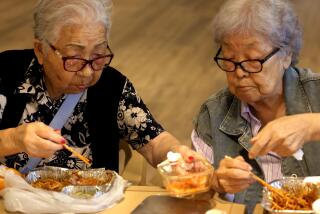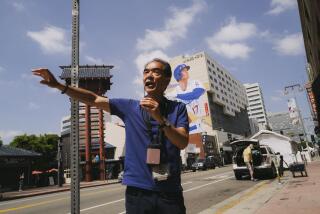Tokyo Park Guards Against Unfriendly Spirits
TOKYO — If you only have a couple of days to tour this city but want to get a feel for the cultural heritage that supports Japan today, make time to visit Ueno.
Four hundred years ago, when Tokyo was not much more than a quiet fishing village, Ueno was founded as a religious community. Its cliff-side location, a couple of miles northeast of the Imperial Palace, was ideal for keeping unfriendly spirits (and unfriendly armies) away from the capital.
Today Ueno is Tokyo’s largest park, where the city’s residents go for quiet relaxation. Its historic temples and shrines have been joined by several of Japan’s most important museums, displaying art that goes back centuries.
If your time is limited, the sights worth seeing are the Tokyo National Museum, Toshogu Shrine, Kiyomizu Kannon Temple (temples are Buddhist, shrines are Shinto), the Shinobazu Pond area and the Ameyoko Market. Allow at least half a day for your visit.
As you might expect, the Tokyo National Museum houses one of the world’s foremost collections of Asian art. If you have any interest at all in screens or scrolls, you’ll wander the halls with delight. My favorite is a pair of screens depicting birds flying from a cliff-side monastery into a golden sky.
An entire building is dedicated to the cultural treasures of Nara, Japan’s ancient religious capital. And you need not read a word of Japanese to know what you’re looking at--most pieces have captions in English.
The Tokyo National Museum also features a fine, modestly priced indoor and outdoor cafe, and language need not be a barrier here, either. As with many other restaurants in Japan, at the entrance are plastic models of what’s on the menu: If you don’t know the name for what you want, point to it.
National Treasure
After the Tokyo National Museum, probably the most popular attraction in the park is the Toshogu Shrine, the shrine to the Sun God of the East. One of Japan’s oldest national treasures, this shrine is dedicated to the memory of the 17th-Century shogun Tokugawa Ieyasu, whose descendants were the de facto rulers of Japan for more than 200 years.
Although the shrine is still in active religious use, visitors are welcome. After entering the shrine’s compound you pass between ordered rows of more than 200 tall bronze lanterns. As you near the shrine a faint scent of sandalwood emanates from tiers of wooden prayer plaques, most with the purple-gowned badger emblem of the Tokugawa clan on one side, swinging in the breeze.
The shrine has an ornamental main gate covered in gold foil. You enter from the side, along a decorative wooden wall filigreed with the carved figures of birds and fish.
As you look around the shrine’s main building and its porches, make sure you look up, too, at the intricate detail work along the beams, at the finely carved griffins atop the golden pillars and at the elaborate system of roof supports.
As you leave, take a closer look at the lanterns. They were erected by the followers of the Tokugawa clan as signals of their loyalty to Ieyasu and his descendants.
A few minutes away by foot you’ll come to the Kiyomizu Kannon Temple amid trees on the edge of a cliff.
From ground level, this temple’s stolid facade may not seem particularly inviting. A surprise awaits, however, if you decide to climb the wide wooden steps that lead to the temple’s main hall.
Facing the hall, with its red man-size lantern and dim interior, are broad, airy porches with a splendid view of Shinobazu Pond and the city beyond.
On the far side of the hall, not visible from the entrance, a series of sun-lit buildings reveal themselves around a spacious courtyard.
Temple of Mercy
From the outside the buildings look firmly planted in the ground, but from within you can see that the entire complex is elevated on pillars.
As you leave this temple, dedicated to the Goddess of Mercy, you’ll probably see groups of martial-arts enthusiasts working out on the tree-shaded walk at its entrance.
You’ll want to descend the stairs to the reed-lined crescent of Shinobazu Pond to view the impressive displays of prize-winning bonsai, just to the left of the tall red torii that marks the entrance to the Benzaiten Temple. It’s hard not to be captivated by these miniature trees in full pink, white and pink-and-white flower, plus the remarkable skill and sense of form required to grow full-grown trees in such fanciful shapes.
The far end of the bonsai and flower exhibit will leave you almost at an entrance to the Ameyoko Market.
But if you have an interest in traditional architecture you may wish to first retrace your steps past the Benzaiten Temple, whose patron is the Goddess of Good Fortune, to the home of the 20th-Century painter Taikan Yokoyama on Ikenohata Avenue, facing the pond. Now a small museum, this tasteful house with its garden represents a model of the elegant simplicity for which Japan and Japanese art has long been esteemed.
Formerly the black market, the Ameyoko Market sprawls for blocks on either side of the main railway line south of Ueno Station. Tucked into the arches of the railway embankment you’ll find numerous teahouses and restaurants, many specializing in seafood.
The end of the day is probably the best time to visit Ameyoko Market. As the light of day wanes, the lights of shops and stalls in the market illuminate stocks of clothing, toys and trinkets, plus fish and foodstuffs, some in packages almost too pretty to open. And if you’re of a mind for more conventional shopping, there are several major department stores right in the area.
-- -- --
Ueno is a major station on the JNR Yamanote line that circles the city of Tokyo, and is the terminus for JNR trains to the north of Japan and for the private railway to Narita Airport. It is also served by the Ginza and Hibiya subway lines.
Information: Japan National Tourist Organization, 624 S. Grand Ave., Suite 2640, Los Angeles 90017, phone (213) 623-1952. It can provide you with a Tokyo city map, which contains a detailed inset for Ueno, and with brochures outlining interesting walks.
More to Read
Sign up for The Wild
We’ll help you find the best places to hike, bike and run, as well as the perfect silent spots for meditation and yoga.
You may occasionally receive promotional content from the Los Angeles Times.






